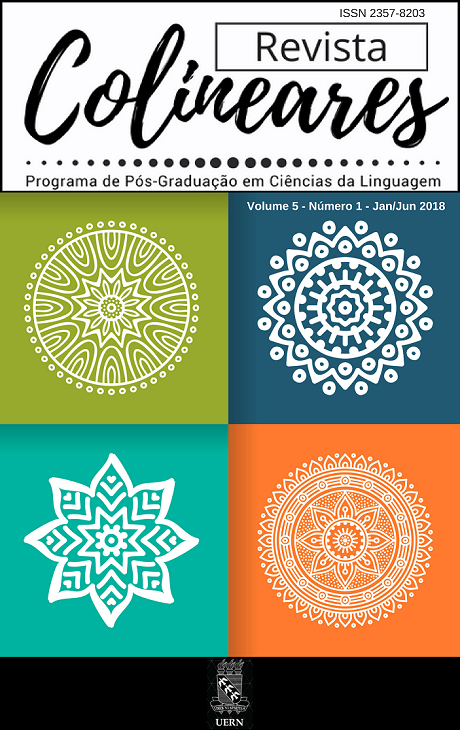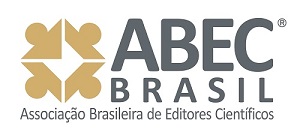THE USE OF THE TERMS "˜INTERFERENCE"™ AND "˜LANGUAGE TRANSFER"™ IN THE ADDITIONAL LANGUAGE AREA: A DISCUSSION ON ITS DIFFERENT ACCEPTIONS
Keywords:
Language Transfer, Complex Adaptive System, Cross-linguistic influenceAbstract
This paper aims to discuss the use of the terms "interference" and "language transfer" as well as to present a historical overview on the development of the theoretical definition of language transfer, from Weinreich (1953) and Lado (1957) to the notion of linguistic influence under the light of Complex Adaptive Systems (RINGBOM, 1985; CENOZ, 2001; HERDINA & JESSNER, 2002; JESSNER, 2008; BRITO, 2011). The term "interference" was neglected (GASS; SELINKER, 1992; CORDER, 1992; ORTEGA, 2009) for displaying a negative impression about intervention from the mother language on an addition language development. Departing from a view of language as a Complex Adaptive System (CAS), the term "transfer" is often called "cross-language influence" and it is a phenomenon that has effects from one language on another. It is also considered to be an intrinsic factor of the multilingual system along the many possible relations among systems in play (L1, L2, and L3) (RINGBOM, 1985; CENOZ, 2001; HERDINA; JESSNER, 2002; KUPSKE, 2016; PEREYRON, 2017; de LOS SANTOS, 2017). In addition, under this prism, language typology and language proficiency will be discussed as being conditioning factors on the process of cross-language influence. Finally, focusing on the phonemic component, the paper fosters a proposal with regards to the term "transfer" based on Larsen-Freeman (2015), who asserts that the process of transfer offers much more than just transferring or coping elements to the developing language system, the author affirms that the process involves creativity, innovation, recombination.
Downloads
References
BECKNER, C.; BLYTHE, R.; BYBEE, J.; CHRISTIANSEN, M.; CROFT, W.; ELLIS, N.; HOLLAND, J.; KE, J.; LARSEN-FREEMAN, D.; SCHOENEMANN, T. Language is a Complex Adaptive System: Position Paper. Language Learning, v. 59, n. 1, 2009. p. 1-26.
BEST, K.; TYLER, M. D. Nonnative and second-language speech perception: Commonalities and complementarities. In: MUNRO, M. J.; BOHN, O. S. (Eds.). Second language speech learning: The role of language experience in speech perception and production. Amsterdam: John Benjamins Publishing Company, 2007. p. 13-34.
BIALYSTOK, E.; BARAC, R. Cognitive affects. In: GROSJEAN, F. & LI, P. The psycholinguistics of Bilingualism. Hoboken: Wiley, 2013. p. 192-213.
BLANK, C.A. A transferência grafo-fônico-fonológica L2 (francês) – L3 (inglês): um estudo conexionista. Dissertação (Mestrado em Letras). Pelotas: Universidade Católica de Pelotas. 2008.
______. A influência grafo-fônico-fonológica na produção oral e no processamento de priming em multilíngues: uma perspectiva dinâmica. Tese (Doutorado em Letras). Universidade Católica de Pelotas, Pelotas. 2013.
BLOOMFIELD, L. Language. New York: Holt, Rinehart, and Wintson, 1945.
BRITO, K. S. Influências interlinguísticas na mente multilíngue: Perspectivas psicolinguísticas e (psico)tipológicas. Tese (Doutorado em Letras). Curitiba: Universidade Federal do Paraná. 2011.
CENOZ, J. The Effect of Linguistic Distance, L2 Status and Age on Cross-linguistic Influence in Third Language Acquisition. In: CENOZ, J.; HUFEISEN, B.; JESSNER, U. Cross-linguistic Influence in Third Language Acquisition: Psycholinguistic Perspectives. Multilingual Matters. Bristol: Multilingual matters, 2001. p. 8-20.
DE BOT, K. The Multilingual Lexicon: Modelling Selection and Control. International Journal of Multilingualism, v.1, n. 1, 2004, p. 17-32.
______. Complexity Theory and Dynamic Systems Theory: Same or different? In: ORTEGA, L.; HAN, Z. (eds.) Complexity Theory and Language Development. Amsterdam: John Benjamins Publishing Company, 2017. p. 51-58.
DE BOT, K.; LOWIE, W.; VERSPOOR, M. (2007) A Dynamic System Theory approach to second language acquisition. Bilingualism: Language and Cognition, v. 10, n. 1, p. 7-21.
DE LOS SANTOS, B. R. A produção da vogal átona final /e/ por porto-algrenses aprendizes de espanhol como segunda língua (LA): uma investigação sobre atrito linguístico em ambiente de LA não-dominante. Dissertação (Mestrado em Letras) Porto Alegre, Universidade Federal do Rio Grande do Sul. 2017.
DEWAELE, J-M. Lexical inventions: French interlanguage as L2 versus L3. Applied Linguistics, v. 19, n. 4,1998, p. 471-490.
ELLIS, N. The Emergence of Language as a Complex Adaptive System. In: SIMPSON, J. (ed.). Routledge Handbook of Applied Linguistics. Amsterdam: Abingdon: Routledge/Taylor Francis, 2011. p. 654-667.
FLEGE, J. E. Second Language Speech Learning: Theory, Findings, and Problems. In: STRANGE, W. (ed.) Speech perception and linguistic experience: issues in cross language research. Timonium, MD: York press, 1995.
FRANCESCHINI, R. Sprachadoption: der Einfluss von Minderheitensprachen auf die Mehrheit, oder: Welche Kompetenzen der Minderheitensprachen haben Minderheitensprachen? Bulletin Suisse de Linguistique Appliquée, v. 69, n. 2. 1999.
FRIES, C. Teaching and Learning English as Foreign Language. Ann Arbor: University of Michigan press, 1945.
GALLARDO DEL PUERTO, F. Is L3 Phonological Competence Affected by the Learner"™s Level of Bilingualism? International Journal of Multilingualism, v. 4, n. 1, 2007, p. 1-16.
GASS, S. M.; SELINKER, L. Introduction. In: GASS, S. M.; SELINKER, L. (eds). Language Transfer in Language Learning. Amsterdam: John Benjamins B. V., 1992.
GREEN, D. W. Control, activation, and resource: A framework and a model for the control of speech in bilinguals. Brain and Language, v. 27, n. 2, 1986/1998, p. 210- 223.
GROJEAN, F. (2013) Introduction. In: GROSJEAN, F. & LI, P. The psycholinguistics of Bilingualism. Hoboken: Wiley-Blackwell, 2013.
______; LI, P. (2013). The psycholinguistics of Bilingualism. Hoboken: WileyBlackwell, 2013.
______; PY; B. La restructuration d"™une première langue: l"™intégration de variants de contact dans la competence de migrants bilingues. La Linguistique, v. 23, 1991, p. 35-60.
HAMMARBERG, B. Roles of L1 and L2 in L3 production and acquisition. In: CENOZ, J; HUFEISEN, B; JESSNER, U. (eds.) Cross-linguistic Influence in Third Language Acquisition: Psycholinguistic Perspectives. Bristol: Multilingual matters, 2001. p. 21-41.
HERDINA, P.; JESSNER, U. A Dynamical Model of Multilingualism: Perspectives of Change in Psycholinguistics. Bristol: Cromwell Press Ltd., 2002.
JESSNER, U. Teaching third languages: Findings, trends and challenges. Language Teaching, v. 41, n. 1, 2008. p. 15-58.
KUPSKE, F. F.. Imigração, atrito e complexidade: a produção das oclusivas iniciais surdas do inglês e do português por sul-brasileiros residentes em Londres. Tese (Doutorado em Letras), Porto Alegre: Universidade Federal do Rio Grande do Sul. 2016.
LADO, R. Linguistics across cultures: applied linguistics for languages teachers. Michigan: University of Michigan Press, 1957.
LARSEN-FREEMAN, D. Chaos/Complexity Science and Second Language Acquisition. Applied Linguistics, v.18, n. 2, 1997, p. 141-165.
______. Complex, dynamics systems: A new transdisciplinary theme for applied linguistics? Language Teaching, v. 45, n. 2, 2011, p. 1-13.
______. Complexity Theory. In: VANPATTEN, B.; WILLIAMS, J. (eds).Theories in Second Language Acquisition: An introduction. Amsterdam: Routledge/Taylor Francis, 2015. p. 227-244.
LENNERBERG, E. Biological Foundations of Language. New York: Wiley, 1967.
MERCER, S. Understanding learner agency as a complex dynamic system. System, v. 39, 2011, p. 427-436.
ODLIN, T. Language Transfer: cross-linguistic influence in language learning. Cambridge: Cambridge University Press, 1989.
OLSEN, S. Errors and compensatory strategies: A study of grammar and vocabulary in texts written by Norwegian learners of English. System, v. 27, n. 2, 1999, p. 191- 200.
ORTEGA, L. Understanding Second Language Acquisition. Oxford: Hachette UH Company, 2009.
PENFIELD, W.; ROBERTS, L. Speech and Brain Mechanisms. Princeton: Princeton University Press, 1959.
PENFIELD, W. Conditioning the uncommited cortex for language learning. Brain. Oxford: Oxford University Press, 1965. p. 787-798.
PEREYRON, L. A produção vocálica por falantes de espanhol (L1), inglês (L2) e português (L3): uma perspectiva dinâmica na (multi) direcionalidade da transferência linguística. Tese (Doutorado em Letras). Porto Alegre, Universidade Federal do Rio Grande do Sul, 2017.
RICHARDS, J. C. (1970) A Non-Contrastive Approach to Error Analysis. ELT journal, v. 25, n. 3, 1970, p. 204-219.
RINGBOM, H. The Influence of Swedish on the English of Finnish Learners, Eric, 1985, p. 39-71.
ROSSI, S. (2006) L´interference lexicale dans l´acquisition d´une troisieme langue: effetlangue seconde ou distance typologique? Dissertação (Mestrado em Letras). Galgary, University of Galgary, 2006.
SELINKER, L. Interlanguage. International Review of Applied Linguistics, v.10, n.3, 1972, p. 209-231.
SCHERESCHEWSKY, L. C.; ALVES, U. K.; KUPSKE, F.F. First language attrition: the effects of English (L2) on Brazilian Portuguese Vot patterns in an L1-dominant environment. Letrônica, v.10, n. 2, 2017, p. 700-716.
SCHERESCHESKY, L. C. O atrito linguístico sobre os padrões de VOT do português: efeitos do inglês (L2) e do alemão (L3) em aprendizes bilíngues e trilíngues. Trabalho de Conclusão de Curso (Letras). Porto Alegre: Universidade Federal do Rio Grande do Sul, 2018.
VAN HELL, J.G.; TANNER, D. Second Language Proficiency and Cross-Language Lexical Activation. Language Learning, v.62, 2012, p. 148-171.
VANPATTEN, B. What is second language acquisition and what is doing in this department? ADFLBulletin, v. 30, n. 30, 1999, p. 49-53.
WALTER, C. (2007) First- to second-language reading comprehension: Not transfer, but access. International Journal of Applied Linguistics, v. 17, n.1, 2007, p. 14-37.
WEINREICH, U. Languages in Contact. The Hague: Mouton, 1953/1964. WUNDER, E.M. Phonological Cross-linguistic Influence in Third or Additional Language Acquisition. 6th New Sounds, 2010.
Downloads
Published
How to Cite
Issue
Section
License
Copyright (c) 2018 Letícia Pereyron

This work is licensed under a Creative Commons Attribution-NonCommercial-ShareAlike 4.0 International License.






